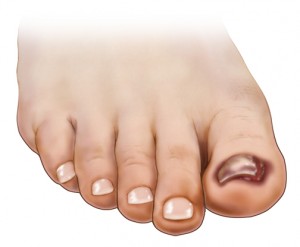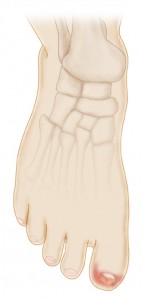The medical term used to describe a toenail that falls off is onychoptosis or onycholysis, which simply indicates a separation of the nail from the nail bed. This phenomenon is usually a result of a fungal infection or a traumatic injury.
The nail tends to appear discolored initially, indicating a separation of the nail from the bed. This is followed by loosening of the nail, which can be quite painful, and may require first aid attention until medical treatment can be obtained.
In serious cases, medical attention should be sought to prevent the spread of infection or permanent damage to the nail matrix (root).
Separation of the nail from the nail bed can result in symptoms ranging from bleeding and discomfort to infection and possible disfigurement. In some cases the nail may appear to fall off for no apparent reason, but there is usually an underlying cause.
What Are The Symptoms of Toenail Loss?
Depending on the cause of the separation, symptoms may include:
With an injury:
- Pain
- Collection of blood under the nail
- Discoloration of the nail
- Bleeding
- Loosening of the nail
With an infection::
- Thickening of the nail
- Brown, green or yellow discoloration
- Pain
- Swelling
- Redness of the surrounding tissue
- Foul odor
- Discharge from under the nail

What Causes a Toenail to Fall Off?
As previously noted, there are two primary reasons for toenail loss: infection and injury. The most common cause of toenail loss is a contagious fungal infection cause by various types of dermatophytes, which are fungi that feed upon the keratin found in the skin and nails.
Dermatophytes can also affect the skin, resulting in athlete’s foot, or tinea pedis. The problem with this is that in a warm, moist environment—i.e., the environment found in shoes and socks—the infection can spread rapidly and transfer to the toenails, resulting in onychomycosis.
Infection is often seen in successive generations of families, likely due to sharing of hygenic products and showers.
In the case of injury, we see the loss of toenails most frequently in sports such as running, soccer, skating, and skiing. Pressure on the nail from shoe gear causes blistering of the skin under the nail and eventually separation of the nail plate. An acute separation may result in bleeding from under the nail.

Treatment Toenail Loss or Separation
The important thing to remember is that the nail will grow back in most cases within three to six months.
If the toenail separation was due to a fungal infection, topical or oral medications may be prescribed, although the effectiveness of these medications is disputed by some doctors.
A very promising new treatment utilizes a laser that specifically targets the fungus underneath the toenail.
In a worst-case scenario, if the nail is deformed and painful, excision of the nail and its root, a procedure known as a matrixectomy, is possible. This will prevent the nail from regrowing and thereby relieve the pain.
If the separation is caused by an injury and the nail is bleeding, apply pressure to the nail for five minutes and repeat as necessary. Your podiatrist may drain the blister and bandage the injured toe.
In some cases, the entire nail will need to be removed to allow for proper healing and regrowth. Anti-inflammatory medications may also be necessary for pain control.
When to See Your Doctor
If your toenail is falling off and you are uncomfortable with self treatment, you should try to bandage the nail to the nail bed and see a doctor as soon as possible.
Otherwise, you may attempt to remove the loose portion, using a nail clipper to prevent accidental tear from the nail bed.
Remember that regrowth will occur naturally. If there is pain, discomfort, immobility, swelling, discoloration, a foul odor, discharge, or further injury, however, you should seek medical attention immediately. Your doctor will be able to treat the symptoms and advise you how to prevent recurrence.
Prevent Your Toenail from Falling Off With These Tips
Here are some tips to help you keep your toenails from falling off.
- Wear shoes made of breathable materials that offer stability, protection and balance.
- Use caution when performing in sports.
- Wear clean socks and shoes daily.
- Practice proper hygiene habits on a daily basis.
- Completely dry your feet after they have come into contact with water.
- At the first sign of breakage, bandage your toe or seek medical attention.
- Never rip or tear at a nail that has partially torn.
- If your toenail is partially detached, hold down the remaining nail with a loose bandage.
- If possible, wear shoes with steel toe boxes when working around heavy objects.
- Trim toenails straight across.
- Wear socks made of breathable materials, such as cotton.
- Shoes should be ½ inch longer than the longest toe.
- During the healing process, take extra care of your toenail.
Talking Your Doctor
Here are some questions you may want to ask your doctor about onychoptosis:
- What home remedies do you recommend?
- What type of bandage should I use to wrap my toenail?
- How often should I change the bandage?
- What has caused my toenail to fall off?
- What should I do if I accidentally tear the nail completely off?
- How long will it be before I can resume my normal activities?




